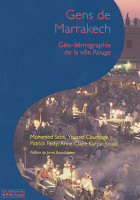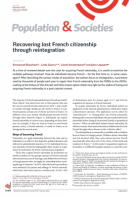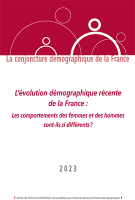
Gens de Marrakech. Géo-démographie de la ville Rouge
Géo-démographie de la ville Rouge
Collection : Cahiers
n° 164, 2009, 352 pages
Préface de Jamal Bourchachen
Introduction
PREMIÈRE PARTIE
Maghreb, Maroc, Marrakech : évolutions historiques et démographiques
- Chapitre 1 • Mille ans de démographie au Maghreb : de la stagnation à l'urbanisation
- Chapitre 2 • Maroc des villes et des champs : une démographie à deux vitesses ?
- Chapitre 3 • Marrakech, entre le zaher et le baten, l'apparence et le caché
DEUXIÈME PARTIE
Quelle insertion économique pour Marrakech ?
- Chapitre 4 • Économie duale et fragilité de l'emploi à Marrakech
- Chapitre 5 • Les métiers de l'informel, une insertion par le bas ?
- Chapitre 6 • Moukef, joutia, souks : les carrefours de l'informel
TROISIÈME PARTIE
Les nouvelles configurations de l'habitat à Marrakech
- Chapitre 7 • L'espace urbain, des origines à la fin du protectorat
- Chapitre 8 • La place de l'habitat populaire aujourd'hui
- Chapitre 9 • Les nouvelles représentations de la ville ancienne
- Chapitre 10 • Cohabitation et requalifications sociales
Conclusion générale
A captivating and mythical city, widely celebrated in art and literature, Marrakech casts a powerful spell upon visitors from across the world and upon its own inhabitants. No-one more than the Marrakchis themselves understands the magic of Jemâa El-Fna square, now classified as a “masterpiece of the human oral and immaterial heritage”. It is the Marrachkis who provide the best custom to the neighbouring souks and who most often enjoy a stroll in the Menara gardens. They are also the main characters of this book, whose aim is to look beyond this enchanted façade and go “behind closed doors” to explore their way of life, their living environment and their working conditions. Applying a demographic and geographic approach, the authors - who all know and love the city - study the social behaviour of its inhabitants against a rapidly evolving urban backdrop, marked architecturally by its history and by the intense mixing of urban and rural populations. The contrast between the European city born of the protectorate and the ancestral Muslim city has become all the more striking in recent years with growing attraction among Europeans for the riads of the medina, many of which have been transformed into guest houses and second homes.
Based on the results of recent Moroccan censuses, major national surveys and personal observations in the field, and illustrated by a series of maps, this study offers an in-depth analysis of the districts of Marrakech and their populations, painting a detailed picture of this complex mosaic and its evolution over time.
Youssef Courbage est chercheur à l'Ined, spécialiste des questions de fécondité dans les pays arabes et musulmans, et plus généralement des questions de perspectives démographiques des pays méditerranéens. Patrick Festy est chercheur à l'Ined et travaille notamment sur les comparaisons internationales des conditions de vie des familles. Mohamed Sebti est géographe et travaille sur la population de Marrakech. Anne-Claire Kurzac-Souali est géographe et enseignante.






